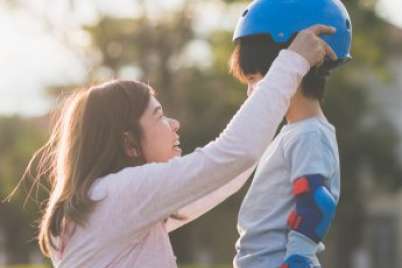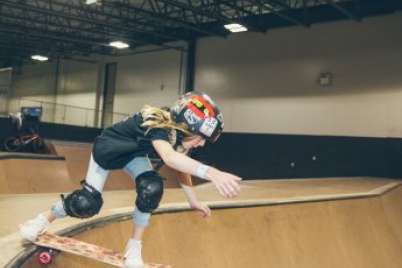
Skateboarding 101: What to know if your kids want to give it a try
In recent years, more than ever before, kids around the globe are picking up their boards to dare ramps and hills, and challenge themselves to attempt gravity-defying tricks. Whether they’re skateboarding as a mode of transportation, a way to express themselves creatively, or a competitive sport, one thing’s for sure: skateboarding offers great physical and social benefits for both beginner and advanced riders.
My tween has been riding for almost a year, and it’s been amazing to watch his balance, coordination, and confidence build with each visit to our local skate park.
“Mom, can we go again after dinner?”
You bet!
Skateboarding offers a full body workout
Riders use a variety of muscles and movement skills to propel the board, and exercise their feet, legs, arms, and torso as they twist and steady themselves with each trick and turn.
Kids learning to skate enhance their coordination
In skateboarding, legs and feet balance on the board, arms and torso move and adjust, and eyes are constantly gauging distances and height. Great coordination will help kids be successful in any activity or sport.
Kids learn perseverance and patience
Learning takes time, and falling (over and over again) is unavoidable. You try a trick and don’t land it. You try again, change your timing, foot stance, and speed. Skateboarding involves plenty of effort and perseverance, skills that can be used throughout life.
Related read: The confidence formula
Skateboarding is about inclusion and personal development
Board taps and other displays of support abound at the skate park. You’ll see beginners and veterans taking turns on a ramp, with words of encouragement if someone falls or doesn’t land a trick. Skateboarding’s diverse and welcoming community is also a great opportunity to form new friendships.
Related read: Skateboarding’s not just for teens
How to keep kids safe while learning to skate
If your child is a raw beginner who’s never stood on a board, it’s important to learn the basics, skate safely, and have fun! While there is no way to stay completely safe while skateboarding, there are things you can do to help avoid skateboard injuries:
Wear protective equipment:
- A properly fitted and secured multi-sport helmet, or one meant specifically for skateboarding.
- Wrist guards.
- Knee and elbow pads.
- Closed-toe shoes with non-slip soles.
- Choose the right skateboard for your child.
Practice safe riding:
- Children should always ride with a parent or adult supervisor.
- Inspect your skateboard before you ride.
- Always skate in a dry, well-lit area away from vehicles, such as at a skatepark.
- Learn turning and slowing techniques, and especially how to stop properly.
- Read up on skateboarding etiquette.
- Take your time learning and only attempt tricks that are at your skill level.






Thank you for this wonderful article on skateboarding and its benefits for kids! It’s great to see the positive impact that skateboarding can have on their balance, coordination, and confidence. I can relate to the excitement your tween feels and the request to go skateboarding again after dinner. The fact that skateboarding offers a full-body workout is fantastic, as it engages multiple muscles and helps kids develop various movement skills. I completely agree that coordination is a crucial skill that can be enhanced through skateboarding and benefit children in other activities and sports. The lessons of perseverance and patience are valuable takeaways from skateboarding, as learning new tricks and overcoming falls require dedication and resilience. I also appreciate the emphasis on inclusion and personal development within the skateboarding community. It’s heartwarming to hear about the support and encouragement that beginners receive from more experienced skaters. One question I have is: What are some safety measures or tips you would recommend for parents to ensure the safety of their kids while skateboarding? Overall, I’m grateful for this insightful article, and it has given me a better understanding of the positive aspects of skateboarding for children. Thank you for sharing!
Hi there! Thanks for your comment! I asked the author of this piece about your question, and here’s what she said:
Wearing well-fitting protective equipment every time they step on their skateboard is a must. It’s essential to have a properly-fitted helmet that’s meant for the sport, and not a bike helmet, as they protect the skull in different ways. Here’s a resource for that: parachute.ca/en/in…eboarding/
If your child is a beginner, check with your city or town and see if they offer lessons at your local skatepark. If they don’t, they might welcome the suggestion!